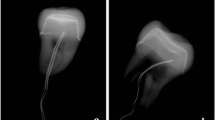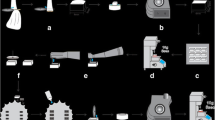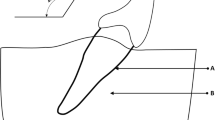Abstract
Since the removal of resin-luted all-ceramic restorations is a challenge, the use of Er:YAG lasers has become popular. The aim of this study was to determine the removal time of monolithic lithium disilicate crowns in different thicknesses and heat transmission to pulp using Er:YAG laser. Forty-five full-coverage monolithic lithium disilicate crowns in 1 mm (n = 15), 1.5 mm (n = 15), and mixed thickness (n = 15) were resin luted on relevant extracted human maxillary first premolars and subjected to Er:YAG laser irradiation for crown removal after 24 h. Laser parameters for each thickness, respectively, were 5 W, 5.6 W, and 5.9 W (10 Hz). The removal time and temperature change values were recorded for each sample. The statistical evaluations were performed using one-way ANOVA variance and post hoc Duncan and Tamhane’s T2 tests (p < 0.05), and Pearson correlation coefficient was used to examine the significance within each group and without group discrimination. All crowns were laser-debonded successfully. The removal time (min:s) at the succeeding laser parameter for each group is as follows: between 2:30 and 4:45 at 5 W power for 1-mm samples, between 5:00 and 11:15 at 5.9 W power for 1.5-mm samples, and between 8:45 and 15:00 at 5.9 W power for samples in mixed thickness. Moreover, it was observed that the temperature changes in the pulp chamber did not exceed the critical value of 5.5 °C for any sample. Er:YAG laser irradiation is an effective and safe method for removal of all-ceramic crowns when appropriate laser parameters are used according to thickness.



Similar content being viewed by others
References
McLean JW (2001) Evolution of dental ceramics in the twentieth century. J Prosthet Dent 85:61–66. https://doi.org/10.1067/mpr.2001.112545
Stewart GP, Jain P, Hodges J (2002) Shear bond strength of resin cements to both ceramic and dentin. J Prosthet Dent 88:277–284. https://doi.org/10.1067/mpr.2002.128034
Oztoprak MO, Tozlu M, Iseri U, Ulkur F, Arun T (2012) Effects of different application durations of scanning laser method on debonding strength of laminate veneers. Lasers Med Sci 27:713–716. https://doi.org/10.1007/s10103-011-0959-1
Van As G (2013) Using the erbium laser to remove porcelain veneers in 60 seconds. J Cosmet Dent 28:20–34
Kellesarian SV, Malignaggi VR, Aldosary KM (2017) Laser assisted removal of all ceramic fixed dental prostheses: a comprehensive review. J Esthet Restor Dent 30:216–222. https://doi.org/10.1111/jerd.12360
Yilanci H, Yildirim ZB, Ramoglu SI (2017) Intrapulpal Temperature Increase During Er:YAG Laser-Aided Debonding of Ceramic Brackets. Photomed Laser Surg 35:217–222. https://doi.org/10.1089/pho.2016.4198
Nalbantgil D, Tozlu M, Oztoprak MO (2014) Pulpal thermal changes following Er-YAG laser debonding of ceramic brackets. ScientificWorldJournal 2014:912429. https://doi.org/10.1155/2014/912429
Mirhashemi AH, Hossaini SMH, Etemadi A, Kharazifard MJ, Bahador A, Soudi A (2019) Effect of Er:YAG and Er,Cr:YSGG lasers on ceramic bracket debonding from composite blocks. Front Dent 16:88–95. https://doi.org/10.18502/fid.v16i2.1359
Mocuta DE, Miron MI, Lungeanu D, Mateas M, Ogodescu E, Todea CD (2022) Laser Er:YAG-Assisted debonding may be a viable alternative to the conventional method for monocrystalline ceramic brackets. Int J Environ Res Public Health 19:14564. https://doi.org/10.3390/ijerph192114564
Grzech-Leśniak K, Matys J, Żmuda-Stawowiak D, Mroczka K, Dominiak M, Brugnera Junior A, Gruber R, Romanos GE, Sculean A (2018) Er:YAG laser for metal and ceramic bracket debonding: An in vitro study on intrapulpal temperature, SEM, and EDS analysis. Photomed Laser Surg 36:595–600. https://doi.org/10.1089/pho.2017.4412
Downarowicz P, Noszczyk P, Mikulewicz M, Nowak R (2020) Thermal effect of Er:YAG and Er,Cr:YSGG used for debonding ceramic and metal orthodontic brackets: An experimental analysis. Adv Clin Exp Med 29:557–563. https://doi.org/10.17219/acem/118844
Walinski CJ, Gibson JE, Colvert DS, Redmond DC, Jafarian JH, Gregory PN, Ou KL (2021) Debonding of leucite-reinforced glass-ceramic veneers using Er, Cr:YSGG laser device: Optimizing speed with thermal safety. Oper Dent 46:100–106. https://doi.org/10.2341/18-005-L
Cifuentes HG, Gómez JC, Guerrero ANL, Muñoz J (2020) Effect of an Er,Cr:YSGG laser on the debonding of lithium disilicate veneers with four different thicknesses. J Lasers Med Sci 11:464–468. https://doi.org/10.34172/jlms.2020.72
AlBalkhi M, Hamadah O (2022) Influence of pulse duration and water/air cooling ratio on the efficiency of Er:YAG 2940 nm laser in debonding of porcelain laminate veneers: An in vitro study. Clin Exp Dent Res 8:843–848. https://doi.org/10.1002/cre2.554
Zhang Y, Rocca JP, Fornaini C, Zhen Y, Zhao Z, Merigo E (2018) Erbium-doped, yttrium-aluminum-garnet laser debonding of porcelain laminate veneers: An ex vivo study. Contemp Clin Dent 9:570–573. https://doi.org/10.4103/ccd.ccd_632_18
Rechmann P, Buu NCH, Rechmann BMT, Finzen FC (2014) Laser all-ceramic crown removal-a laboratory proof-of-principle study-phase 2 crown debonding time. Lasers Surg Med 46:636–643. https://doi.org/10.1002/lsm.22280
Rechmann P, Buu NCH, Rechmann BMT, Finzen FC (2015) Laser all-ceramic crown removal and pulpal temperature--a laboratory proof-of-principle study. Lasers Med Sci 30:2087–2093. https://doi.org/10.1007/s10103-015-1738-1
Deeb JG, Bencharit S, Dalal N, Abdulmajeed A, Grzech-Leśniak K (2019) Using Er: YAG laser to remove lithium disilicate crowns from zirconia implant abutments: An in vitro study. PLoS One 14:e0223924. https://doi.org/10.1371/journal.pone.0223924
Gurney ML, Sharples SD, Phillips WB, Lee DJ (2016) Using an Er,Cr:YSGG laser to remove lithium disilicate restorations: A pilot study. J Prosthet Dent 115:90–94. https://doi.org/10.1016/j.prosdent.2015.08.003
Tocchio RM, Williams PT, Mayer FJ, Standing KG (1993) Laser debonding of ceramic orthodontic brackets. Am J Orthod Dentofac Orthop 103:155–162. https://doi.org/10.1016/S0889-5406(05)81765-2
Morford CK, Buu NC, Rechmann BM, Finzen FC, Sharma AB, Rechmann P (2011) Er:YAG laser debonding of porcelain veneers. Lasers Surg Med 43:965–974. https://doi.org/10.1002/lsm.21144
Matsumoto K (2000) Lasers in Endodontics. Dent Clin N Am 44:889–907
Karagoz-Yildirak M, Gozneli R (2020) Evaluation of rebonding strengths of leucite and lithium disilicate veneers debonded with an Er:YAG laser. Lasers Med Sci 35:853–860. https://doi.org/10.1007/s10103-019-02872-8
Barwacz CA, Hernandez M, Husemann RH (2014) Minimally invasive preparation and design of a cantilevered, all-ceramic, resin-bonded, fixed partial denture in the esthetic zone: a case report and descriptive review. J Esthet Restor Dent 26(5):314–323. https://doi.org/10.1111/jerd.12086
Bishara SE, Ostby AW, Laffoon J, Warren JJ (2008) Enamel cracks and ceramic bracket failure during debonding in vitro. Angle Orthod 78(6):1078–1083. https://doi.org/10.2319/112007-540.1
Rechmann P, Buu NC, Rechmann BM, Le CQ, Finzen FC, Featherstone JD (2014) Laser all-ceramic crown removal-a laboratory proof-of-principle study-phase 1 material characteristics. Lasers Surg Med 46(8):628–635. https://doi.org/10.1002/lsm.22279
Raab WH (1992) Temperature related changes in pulpal microcirculation. Proc Finn Dent Soc 88:469–479
Kodonas K, Gogos C, Tziafas D (2009) Effect of simulated pulpal microcirculation on intrapulpal temperature changes following application of heat on tooth surfaces. Int Endod J 42:247–252. https://doi.org/10.1111/j.1365-2591.2008.01508.x
Author information
Authors and Affiliations
Contributions
Gozneli Rifat: conceptualization, methodology, validation, formal analysis, investigation, resources, writing, review, editing, visualization, supervision, and project administration.
Sendurur Tansu: validation, formal analysis, investigation, resources, data curation, and writing original draft.
Corresponding author
Ethics declarations
Ethical approval
This article does not contain any studies with human participants or animals performed by any of the authors. This article only contains a study with test samples prepared by using extracted human maxillary premolars that were previously extracted for periodontal reasons. Although no human participants or animals were performed, this study was approved by the university human research ethics committee and all procedures performed in studies (involving human participants) were in accordance with the ethical standards of the institutional and/or national research committee and with the 1964 Helsinki declaration and its later amendments or comparable ethical standards.
Competing interests
The authors declare no conflict of interest.
Additional information
Publisher’s note
Springer Nature remains neutral with regard to jurisdictional claims in published maps and institutional affiliations.
Rights and permissions
Springer Nature or its licensor (e.g. a society or other partner) holds exclusive rights to this article under a publishing agreement with the author(s) or other rightsholder(s); author self-archiving of the accepted manuscript version of this article is solely governed by the terms of such publishing agreement and applicable law.
About this article
Cite this article
Gozneli, R., Sendurur, T. Er:YAG laser lithium disilicate crown removal: removal time and pulpal temperature change. Lasers Med Sci 38, 164 (2023). https://doi.org/10.1007/s10103-023-03832-z
Received:
Accepted:
Published:
DOI: https://doi.org/10.1007/s10103-023-03832-z




